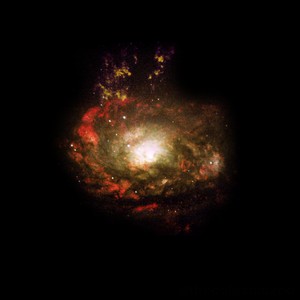Astronomy:Circinus Galaxy
| Circinus Galaxy | |
|---|---|
 A Hubble Space Telescope (HST) image of the core of the Circinus Galaxy. | |
| Observation data (J2000 epoch) | |
| Constellation | Circinus |
| Right ascension | 14h 13m 9.9s[1] |
| Declination | −65° 20′ 21″[1] |
| Redshift | 426 ± 25 km/s |
| Distance (comoving) | 3.14 ± 0.22 Mpc (10.2 ± 0.718 Mly)h−10.6774[1] |
| Apparent magnitude (V) | 12.1[1] |
| Characteristics | |
| Type | SA(s)b[1] |
| Size | 14.85 kpc × 6.09 kpc (48,430 ly × 19,860 ly) (diameter; 2MASS K-band total isophote)[1][lower-alpha 1] 10.38 kpc × 5.19 kpc (33,855 ly × 16,928 ly) (diameter; ESO 90% total B-band)[1][lower-alpha 1] |
| Apparent size (V) | 6.9′ × 3.0′[1] |
| Other designations | |
| ESO 97-G13,[1] LEDA 50779 | |
The Circinus Galaxy (ESO 97-G13) is a Seyfert galaxy[2] in the constellation of Circinus. It is located 4 degrees below the Galactic plane, and, at a distance of 4.0 Mpc (13 Mly), is one of the closest major galaxies to the Milky Way.[3] The galaxy is undergoing tumultuous changes, as rings of gas are likely being ejected from the galaxy.[4] Its outermost ring is 1400 light-years across while the inner ring is 260 light-years across.[citation needed] Although the Circinus galaxy can be seen using a small telescope, it was not noticed until 1977[5] because it lies close to the plane of the Milky Way and is obscured by galactic dust. The Circinus Galaxy is a Type II Seyfert galaxy and is one of the closest known active galaxies to the Milky Way, though it is probably slightly farther away than Centaurus A.
Circinus Galaxy produced supernova SN 1996cr, which was identified over a decade after it exploded. This supernova event was first observed during 2001 as a bright, variable object in a Chandra X-ray Observatory image, but it was not confirmed as a supernova until years later.
The Circinus Galaxy is one of twelve large galaxies in the "Council of Giants" surrounding the Local Group in the Local Sheet.[6] One object is possibly a satellite of the Circinus Galaxy, known as HIZOA J1353-58. HIZOA J1353-58 was discovered in a survey of neutral hydrogen (H I) and is located within the Zone of Avoidance.[7]
NuSTAR detected a ULX at the edge of this galaxy, a Black hole about 100 times the mass of the Sun. [8][9]
Notes
References
- ↑ 1.0 1.1 1.2 1.3 1.4 1.5 1.6 1.7 1.8 "Detailed Information for Object ESO 97-G13". NASA/IPAC Extragalactic Database. https://ned.ipac.caltech.edu/cgi-bin/objsearch?objname=ESO+97-G13&extend=no&hconst=67.74&omegam=0.3089&omegav=0.6911&corr_z=1&out_csys=Equatorial&out_equinox=J2000.0&obj_sort=RA+or+Longitude&of=pre_text&zv_breaker=30000.0&list_limit=5&img_stamp=YES.
- ↑ "NAME Circinus Galaxy". SIMBAD. Centre de données astronomiques de Strasbourg. http://simbad.u-strasbg.fr/simbad/sim-basic?Ident=NAME+Circinus+Galaxy.
- ↑ Maiolino, R.; Krabbe, A.; Thatte, N.; Genzel, R. (1998). "Seyfert Activity and Nuclear Star Formation in the Circinus Galaxy". The Astrophysical Journal 493 (2): 650–65. doi:10.1086/305150. Bibcode: 1998ApJ...493..650M.
- ↑ Izumi, Takuma; Wada, Keiichi; Imanishi, Masatoshi; Nakanishi, Kouichiro; Kohno, Kotaro; Kudoh, Yuki; Kawamuro, Taiki; Baba, Shunsuke et al. (2023-11-03). "Supermassive black hole feeding and feedback observed on subparsec scales" (in en). Science 382 (6670): 554–559. doi:10.1126/science.adf0569. ISSN 0036-8075. https://www.science.org/doi/10.1126/science.adf0569.
- ↑ Inglis, Mike (2004). Astronomy of the Milky Way: Observer's Guide to the Southern Sky. New York, New York: Springer. p. 103. ISBN 978-1-85233-742-1. https://books.google.com/books?id=1r0qvMjSCGAC&pg=SA3-PA103.
- ↑ McCall, Marshall L. (29 April 2013). "A Council of Giants". Monthly Notices of the Royal Astronomical Society 440 (1): 405–426. 10 March 2014. doi:10.1093/mnras/stu199. Bibcode: 2014MNRAS.440..405M.
- ↑ Staveley-Smith, L.; Kraan-Korteweg, R. C.; Schröder, A. C.; Henning, P. A.; Koribalski, B. S.; Stewart, I. M.; Heald, G. (2016). "The Parkes H I Zone of Avoidance Survey". The Astronomical Journal 151 (3): 52. doi:10.3847/0004-6256/151/3/52. Bibcode: 2016AJ....151...52S.
- ↑ https://www.jpl.nasa.gov/images/pia17560-black-holes-of-the-circinus-galaxy
- ↑ https://www.nasa.gov/image-article/black-holes-of-circinus-galaxy/
External links
- Chandra X observatory Examines Black Holes Large and Small in Nearby Galaxy
- The Hubble European Space Agency picture and information
- NASA Astronomy Picture of the Day: The Circinus Galaxy (4 December 2000)
Coordinates: ![]() 14h 13m 9.9s, −65° 20′ 21″
14h 13m 9.9s, −65° 20′ 21″
 |

